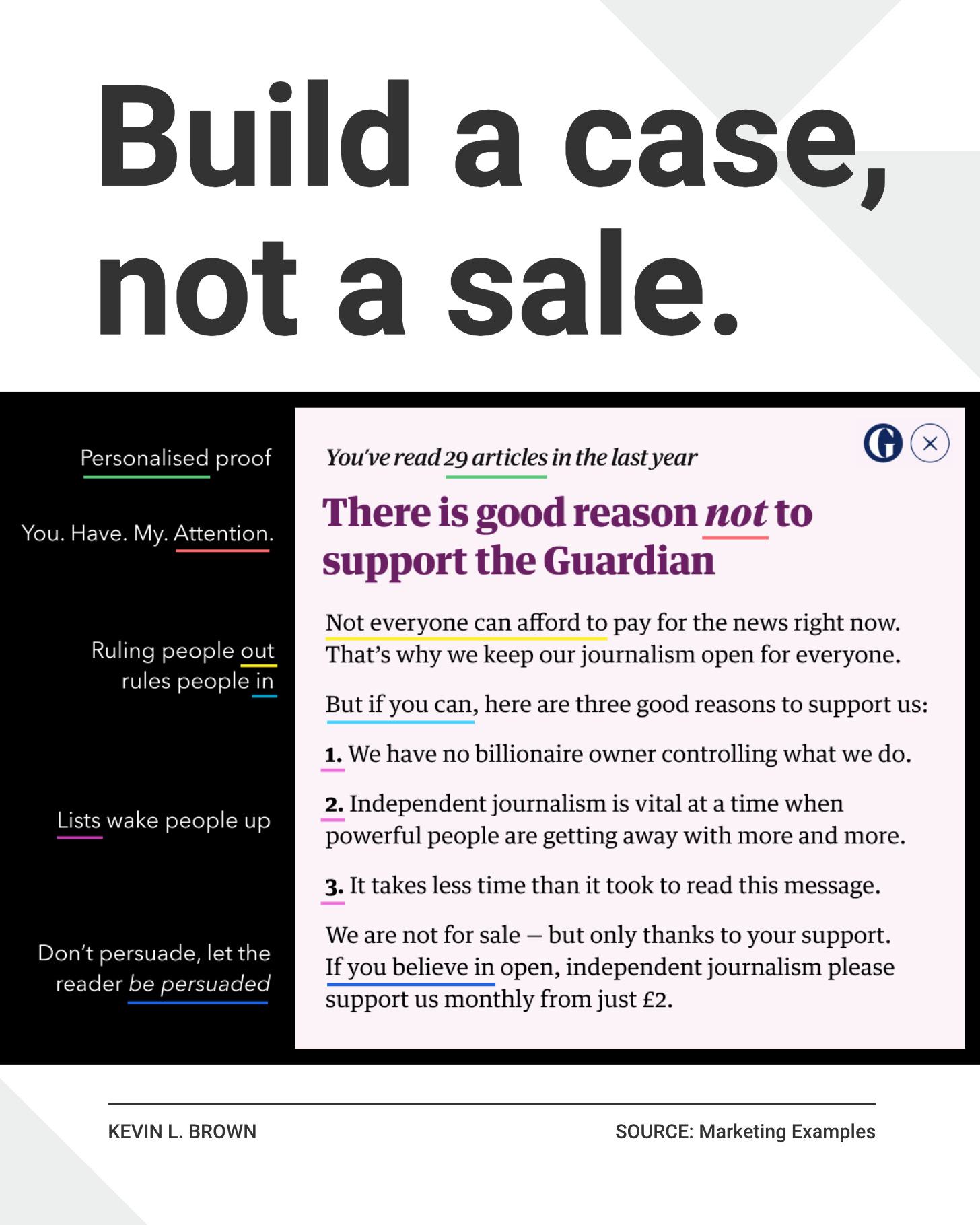Build a case, not a sale.
Don’t sell to donors. Construct an argument.
Here’s how:
Provide them personalized proof.
Get and keep their attention.
Rule out to rule them in.
Use lists for clarity.
Don’t persuade.
See above.
This image shows the power of great copywriting. Compared to all the less-than-exciting nonprofit sales pitches out there, which messaging do you think drives the best fundraising results?
(Hint: this copy helped The Guardian raise $30 million in donations.)
Because “common sense is the enemy of sticky messages,” says the book Made to Stick. “When messages sound like common sense, they float gently in one ear and out the other.”
So make your case compelling, not commercial.
Build an argument, not an advertisement.
💪🏽💛
The daily bonus
I reference Harry Dry often. He’s the wordsmith behind Marketing Examples — the source of the image above.
Now, you can learn all his secrets in this video.
The host of the interview (David Perell) says:
Harry Dry is the best copywriter I know.
He's built a 130,000-person newsletter teaching people how to do it, and by the end of this interview, you'll be at least a Green Belt in copywriting.
Some of his rules for writing:
1) A great sentence is a good sentence made shorter.
2) Writing great copy begins with having something to say in the first place.
3) Copy is like food. How it looks matters.
4) Since the look of copy matters so much, don't write copy in Google Docs. Write it in Figma (so you can write and design at the same time).
5) Kaplan's Law of Words: Any word that isn't working for you is working against you.
6) You know a paragraph is ready to ship when there's nothing left to remove. It's like a Jenga tower. The entire thing should collapse if you remove something.
7) Make a promise in the title so the reader knows exactly what they're going to get if they click. Then, deliver on the promise.
8) The three laws of copywriting: (1) Make it concrete, (2) make it visual, and (3) make it falsifiable.
9) Make it concrete: Don't be abstract. For an example, say you're writing about habits. Don't talk about "productive routines." That's abstract. Write about "waking up at 6am to write" instead. It's concrete — and much more vibrant.
10) Make it visual: People see in pictures. This is why instead of memorizing card numbers directly, world memory champions memorize cards by turning them into pictures and then back to cards.
11) Make it falsifiable: When you write a sentence that's true or false, you put your head on the chopping block, which makes people sit up in their seat.
12) When has a falsifiable statement resonated? Galileo got sentenced to a decade of house arrest for saying that the earth spins around the sun. That's a falsifiable sentence. But nobody would've done anything if he'd said that the earth has a harmonious connection with a celestial object.
13) Write with the delete key. Using fewer words lets you be more impactful with the words you keep.
14) The job of a sales page is to make a bold claim at the top. Then spend the rest of the page backing up what you've said... with a ridiculous amount of proof.
15) If your competitor could've written the sentence, cut it.
16) Good copy is differentiated. Here's an example: Elon Musk shouldn't write "The Cybertruck is the world's best truck." Ford or Dodge can write that sentence. But only Elon can write: "The Cybertruck is tougher than an F-150 and faster than a Porsche."
17) Some days, the writing comes easily. Some days, it takes sweat. The reader doesn't care if you wrote for two minutes, two hours, or two days. The ink looks the same.
18) Great copy reads like your customer wrote it. Talk to them.
Sneak peek
Coming up in tomorrow’s newsletter:
The power of problems.
How to open your next fundraising pitch with force.


